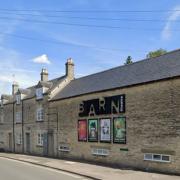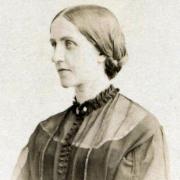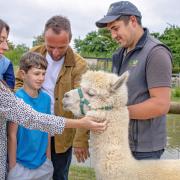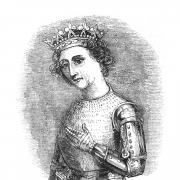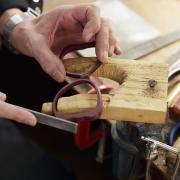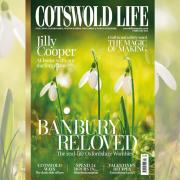‘Come on, girls!’ Marie Louise French sing-songs over a weather-washed fence, into the green of a field glistening under a cold Oxfordshire Cotswold sky.
The girls don’t need to be called twice.
(Picture, if you will, the stampede as doors open on a particularly spectacular Boxing Day sale at Harrods.)
Full of joie de vivre, they skip, run, cavort towards us: 20-odd baa-ing sheep, overcome with happiness at the thought of Marie Louise… and (let’s be cynical here) the handfuls of delicious carrots she brings with her.
Well, nearly all of them run over.
‘Who’s that over there?’ Marie Louise’s sister – and fellow sheep enthusiast – Joan Mordue asks, squinting into the winter sun at an outlier, still busy munching the gourmet grass.
‘I expect it’s Dandelion. She is rather deaf.’
Dandelion the Cotswold sheep is 11 years old, with one-and-a-quarter teeth remaining. They’d be worried about her, were it not for her obvious health and happiness: as roly-poly as a robust teenager.

Nor is she the matriarch of the flock; that honour belongs to 12-year-old Hazel, one of the black-faced Oxford Downs. ‘She’s got it on her today,’ Joan says. ‘I had to go over the edge of the gate this morning because she was doing her best to get out.’
Hazel is so completely toothless, she makes Dandelion look like Janet Street-Porter… not that that’s stopping her plunging her head into the feed bucket, determined to root out the last carroty atom.
‘Look at their wool,’ Marie Louise says, as the younger girls good-naturedly jostle and bleat. I run my fingers over tight, creamy crimps, the various fleeces slightly different. One is fine bouclé; another a looser curl. No wonder, with their luxurious depth of cover, none feel the biting cold.
Later, back at the tack room where we drink warming coffee, Joan shows me a bag of the wool she sells at fairs. It’s like gossamer.
YEW TREE FARM in the village of Standlake has no ordinary flock of sheep. It was 13 years ago that Marie Louise decided to create a good flock of rare breeds: a ‘legacy’, as she termed it; doing her bit to help farm animals continually under threat of disappearing.
She laughs, ‘Sheep find 101 reasons why they should die. But I thought: No, I’m going to give it a go.’
It made sense to concentrate on local rare breeds: so she began with Oxford Downs, a colossus of a sheep that originated next door in Stanton Harcourt, back in the 1930s. Joan, plus older sister Helen, both pitched in to help.

‘I was pretty much in the dark,’ Marie Louise admits. ‘We got our first five sheep and ended up with problems in the very first week. The ewe with lambs developed mastitis. I rang up a local shepherd and he said, ‘Just milk her and get it through’. Which was easier said than done with sheep that had never been handled!’
Especially this sheep – Olive.
(I’m picturing a Benny Hill chase.)
‘Olive knew her own mind,’ Joan says, darkly. ‘She produced some good lambs but she was very awkward.’
Olive notwithstanding, the sisters were determined – by hook or by shepherd’s crook – to persist. Besides which, the sheep were beginning to win them over: wily and full of personality, they might not get into Mensa; but for sure they defied any stereotype about being bottom of the farmyard IQ pile.
The Cotswold sheep Marie Louise also acquired are of much older heritage than the Oxford Downs. Known as the Cotswold Lion, thanks to its golden fleece, the breed came over with the Romans (so many people claim). Tacitus, in the 2nd Century AD, wrote about a flourishing cloth trade in Cirencester. And – certainly by the Middle Ages – the wool of the Cotswold sheep was famous: European lore spoke enviously of the best wool being from England; and the best English wool from the Cotswolds.

And that was all down to the Cotswold sheep. Experts estimate that, at the height of the wool trade, there were half a million of them grazing the hills of oolite. What’s beyond doubt is the wealth they brought to the towns and villages of the area they now called home. You only have to look at the stupendous wool churches – built by gratefully rotund wool merchants – Cirencester (where a whole abbey waxed fat), Northleach, Winchcombe and Burford, amongst them. In Chipping Campden’s glorious church of St James lies buried one of its generous benefactors, William Greville, who saw fit to have inscribed on his tomb of 1401, ‘the flower of the wool-merchants of all England’.
That’s the good news.
The brutal truth is, economies have changed since the 1400s: if you keep Cotswold sheep in the hope of financing your local church today, you might be disappointed.
On the other hand, if you’ve wit and imagination – as this family has – you still might be able to turn a much-loved flock into something of a viable business.
YOU WON’T TURN much of a profit on Cotswold sheep meat nowadays: the breed is slow to mature; the joints are bigger than most tables require.
The fleece is a different story. We sit surrounded by beautiful rugs and cushions, made by Joan – just for fun – from the flock’s wool. She washes it in Fairy Liquid – soaked for two or three days; rinsed and dried – and sells for substantially more than conventional wool.
‘The spinners go mad for it,’ she says, teasing a lock out to the most decent of lengths; there’s also the ‘fluff’ in between, perfect for needle-felting.
Natural dyes come courtesy of a friend in Cheltenham, Sally Scanlon, who runs Brentfox Yarns, which also sells spun Cotswold fleece in skeins for knitting.
But that’s not the essence of the business story.

For that, enter Joan’s son, Eddie, a Harper Adams graduate with some cracking ideas. Under the name Traditional Garden Growers, he’s developed a soil-enhancing wool pellet that saw him make the finals of the British Wool Innovation Awards.
‘People have heard of them for slugs – and they do deter slugs; but these increase the porosity of the soil, as well as giving it natural nutrients,’ Joan says.
The pellets have been a couple of years in development, but there’s no doubt they do what they say on the tin: ‘Eddie planted up a goldfish bowl and put a couple of beans in; it’s really interesting because you could see around the wool pellet a much stronger growth of roots.’ He’s currently working with Harper Adams on further pellet research, including a vegan line.
Eddie also helps blade-shear the flock, alongside Fred The Shearer (AKA Fred Bonestroo) from Cirencester. They’ll get an average of 5kg per sheep.
‘With a commercial flock, the sheep are taken back to the skin. We blade-shear each spring, pulling the wool back so we can see the natural break: it almost says ‘Cut here!’
‘It’s by hand, and a really calm process. The sheep are left with a little bit of a covering. Even so, sometimes – when they’re shorn – they don’t recognise each other, so they have a little biff!’
Generally, though, they’re a calm breed. They can recognise up to around a dozen human faces; they know their fields; they know their territory.
There are minor fallings out. Ozzie the Cotswold sheep – who contentedly walks to the field, led by Marie Louise on a lead – has a proud scar on his head as testament.
But they’re also affectionate, especially with each other. Dandelion and her grown-up daughter Primrose still form a tight bond.
Soon it will be time for lambing again.
‘The Cotswold are very attentive as mothers, whereas the Oxfords are quite self-indulgent,’ Marie Louise says.
Yummy mummies.

THERE ARE FEWER than 1,400 Cotswold sheep in the country today. Even so, the Cotswold Sheep Society that the sisters help run has a healthy 120 members from all walks of life. Some keep the sheep; others are perhaps spinners or weavers. Anyone with an interest, in fact.
The society works hard to promote the breed, providing information on everything from history to description of the perfect specimen – the ideal example of which was written by Mr WS Harmer of Cirencester back in 1891.
‘The Head should be wide between the eyes,’ he begins, ‘and the eye itself, full, dark and prominent, but mild and kindly, and in no way coarse about the brow.’

Easier-to-digest examples come from paintings, such as the bucolic scene showing Russell Swanwick’s Cirencester flock, as painted by Richard Whitford back in 1876. It shows sheep with an almost square physique, big muscular neck (‘giving the animal a grand appearance’), and an adorable fine tuft of wool on the forehead.
‘The painting was up for auction a little while ago, and we thought we’d quite like it.’
That was until bids topped £40,000…
Before Covid, Marie Louise, Joan and Helen were stalwarts of various shows around the country, with champions such as Brian, who beat off all competition at the Three Counties.
It takes weeks to get the animals show-ready – plus a lot of Fairy Liquid.
‘But we are thinking of showing again.’
THERE IS SOMETHING utterly joyful about the scenes at Yew Tree Farm, where water birds reel overhead, and owl boxes invite new inhabitants to join them.
The animals graze naturally, supplemented only when needs-be on hay grown on the farm.
‘We’ve a gravel bed, which helps with drainage – we don’t get the sort of claggy clay that doesn’t help the grass or the sheep.’
‘The hay is amazing. We’ve never put a chemical on it. I’ve got horses and they’re notoriously fussy – but they love it. It’s a really nice soft hay, with lots of flowers.’
Soon, if things go to plan, four of the sheep will be in lamb.
‘But they all look out for everybody’s lambs,’ Marie Louise says.
‘Though some are lamb stealers. If they haven’t got one, they’ll pinch another!’
The days of hills covered in huge flocks of these sheep are long gone; but, thanks to people such as these sisters, there are still pockets that William Greville – flower of all wool merchants – might recognise even today.
For more on Eddie’s wool pellets and other natural products, visit traditionalgardengrowers.co.uk












